Adriana Kovashka
A Multimodal Recaptioning Framework to Account for Perceptual Diversity in Multilingual Vision-Language Modeling
Apr 19, 2025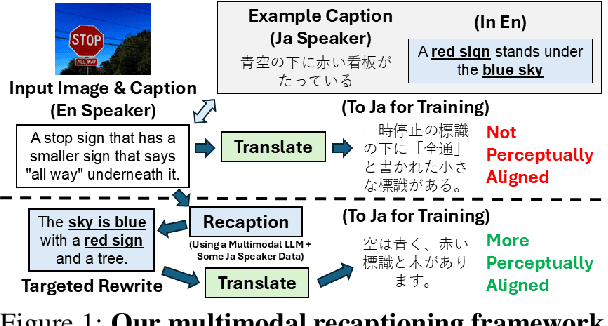
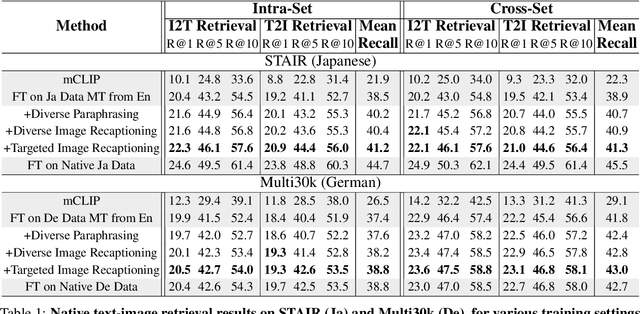
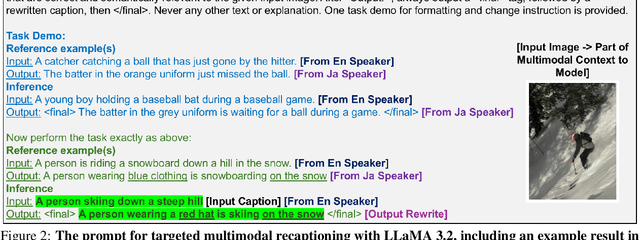
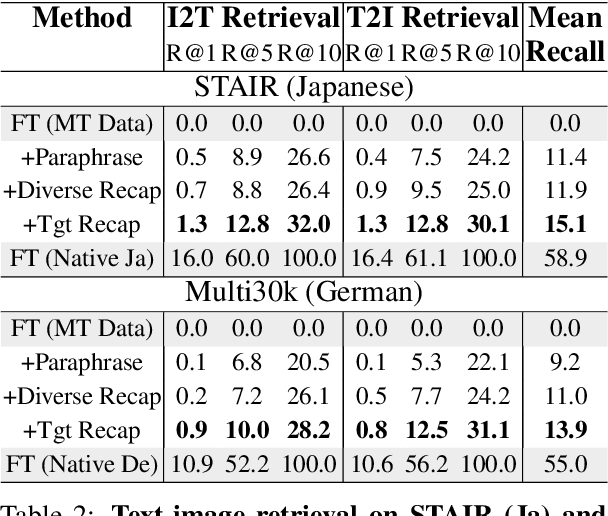
Abstract:There are many ways to describe, name, and group objects when captioning an image. Differences are evident when speakers come from diverse cultures due to the unique experiences that shape perception. Machine translation of captions has pushed multilingual capabilities in vision-language models (VLMs), but data comes mainly from English speakers, indicating a perceptual bias and lack of model flexibility. In this work, we address this challenge and outline a data-efficient framework to instill multilingual VLMs with greater understanding of perceptual diversity. We specifically propose an LLM-based, multimodal recaptioning strategy that alters the object descriptions of English captions before translation. The greatest benefits are demonstrated in a targeted multimodal mechanism guided by native speaker data. By adding produced rewrites as augmentations in training, we improve on German and Japanese text-image retrieval cases studies (up to +3.5 mean recall overall, +4.7 on non-native error cases). We further propose a mechanism to analyze the specific object description differences across datasets, and we offer insights into cross-dataset and cross-language generalization.
Investigating and Improving Counter-Stereotypical Action Relation in Text-to-Image Diffusion Models
Mar 13, 2025Abstract:Text-to-image diffusion models consistently fail at generating counter-stereotypical action relationships (e.g., "mouse chasing cat"), defaulting to frequent stereotypes even when explicitly prompted otherwise. Through systematic investigation, we discover this limitation stems from distributional biases rather than inherent model constraints. Our key insight reveals that while models fail on rare compositions when their inversions are common, they can successfully generate similar intermediate compositions (e.g., "mouse chasing boy"). To test this hypothesis, we develop a Role-Bridging Decomposition framework that leverages these intermediates to gradually teach rare relationships without architectural modifications. We introduce ActionBench, a comprehensive benchmark specifically designed to evaluate action-based relationship generation across stereotypical and counter-stereotypical configurations. Our experiments validate that intermediate compositions indeed facilitate counter-stereotypical generation, with both automatic metrics and human evaluations showing significant improvements over existing approaches. This work not only identifies fundamental biases in current text-to-image systems but demonstrates a promising direction for addressing them through compositional reasoning.
Towards Generalization of Tactile Image Generation: Reference-Free Evaluation in a Leakage-Free Setting
Mar 10, 2025Abstract:Tactile sensing, which relies on direct physical contact, is critical for human perception and underpins applications in computer vision, robotics, and multimodal learning. Because tactile data is often scarce and costly to acquire, generating synthetic tactile images provides a scalable solution to augment real-world measurements. However, ensuring robust generalization in synthesizing tactile images-capturing subtle, material-specific contact features-remains challenging. We demonstrate that overlapping training and test samples in commonly used datasets inflate performance metrics, obscuring the true generalizability of tactile models. To address this, we propose a leakage-free evaluation protocol coupled with novel, reference-free metrics-TMMD, I-TMMD, CI-TMMD, and D-TMMD-tailored for tactile generation. Moreover, we propose a vision-to-touch generation method that leverages text as an intermediate modality by incorporating concise, material-specific descriptions during training to better capture essential tactile features. Experiments on two popular visuo-tactile datasets, Touch and Go and HCT, show that our approach achieves superior performance and enhanced generalization in a leakage-free setting.
CAP: Evaluation of Persuasive and Creative Image Generation
Dec 10, 2024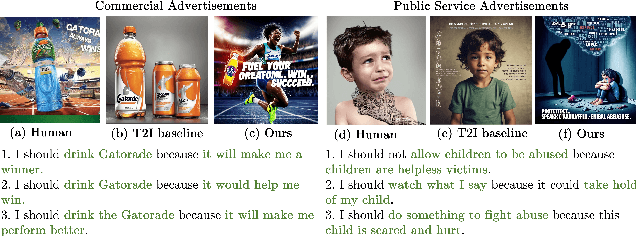
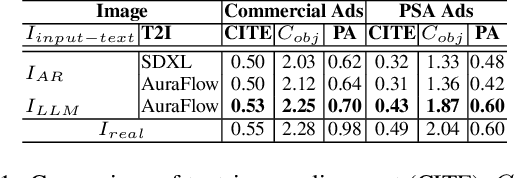
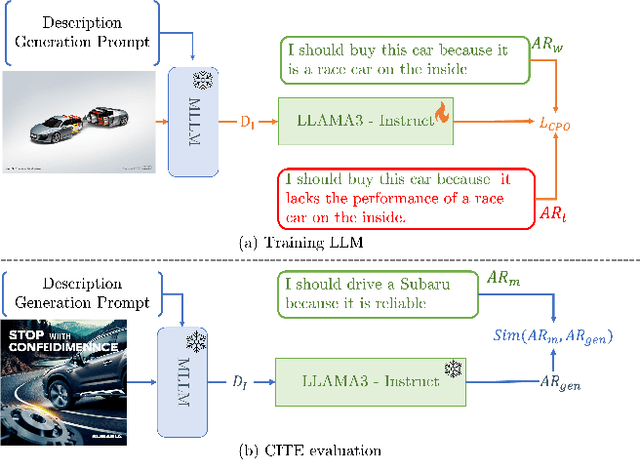

Abstract:We address the task of advertisement image generation and introduce three evaluation metrics to assess Creativity, prompt Alignment, and Persuasiveness (CAP) in generated advertisement images. Despite recent advancements in Text-to-Image (T2I) generation and their performance in generating high-quality images for explicit descriptions, evaluating these models remains challenging. Existing evaluation methods focus largely on assessing alignment with explicit, detailed descriptions, but evaluating alignment with visually implicit prompts remains an open problem. Additionally, creativity and persuasiveness are essential qualities that enhance the effectiveness of advertisement images, yet are seldom measured. To address this, we propose three novel metrics for evaluating the creativity, alignment, and persuasiveness of generated images. Our findings reveal that current T2I models struggle with creativity, persuasiveness, and alignment when the input text is implicit messages. We further introduce a simple yet effective approach to enhance T2I models' capabilities in producing images that are better aligned, more creative, and more persuasive.
Quantifying the Gaps Between Translation and Native Perception in Training for Multimodal, Multilingual Retrieval
Oct 02, 2024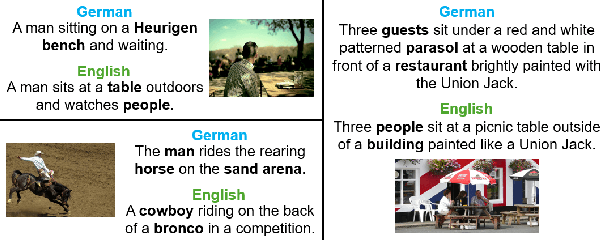

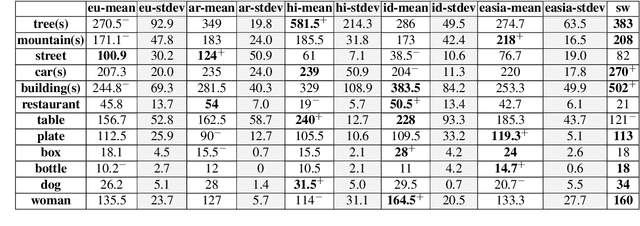
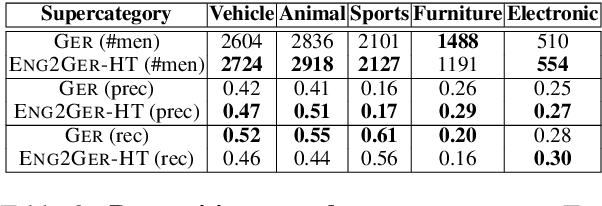
Abstract:There is a scarcity of multilingual vision-language models that properly account for the perceptual differences that are reflected in image captions across languages and cultures. In this work, through a multimodal, multilingual retrieval case study, we quantify the existing lack of model flexibility. We empirically show performance gaps between training on captions that come from native German perception and captions that have been either machine-translated or human-translated from English into German. To address these gaps, we further propose and evaluate caption augmentation strategies. While we achieve mean recall improvements (+1.3), gaps still remain, indicating an open area of future work for the community.
Benchmarking VLMs' Reasoning About Persuasive Atypical Images
Sep 16, 2024



Abstract:Vision language models (VLMs) have shown strong zero-shot generalization across various tasks, especially when integrated with large language models (LLMs). However, their ability to comprehend rhetorical and persuasive visual media, such as advertisements, remains understudied. Ads often employ atypical imagery, using surprising object juxtapositions to convey shared properties. For example, Fig. 1 (e) shows a beer with a feather-like texture. This requires advanced reasoning to deduce that this atypical representation signifies the beer's lightness. We introduce three novel tasks, Multi-label Atypicality Classification, Atypicality Statement Retrieval, and Aypical Object Recognition, to benchmark VLMs' understanding of atypicality in persuasive images. We evaluate how well VLMs use atypicality to infer an ad's message and test their reasoning abilities by employing semantically challenging negatives. Finally, we pioneer atypicality-aware verbalization by extracting comprehensive image descriptions sensitive to atypical elements. Our findings reveal that: (1) VLMs lack advanced reasoning capabilities compared to LLMs; (2) simple, effective strategies can extract atypicality-aware information, leading to comprehensive image verbalization; (3) atypicality aids persuasive advertisement understanding. Code and data will be made available.
Enhancing Weakly-Supervised Object Detection on Static Images through (Hallucinated) Motion
Sep 15, 2024Abstract:While motion has garnered attention in various tasks, its potential as a modality for weakly-supervised object detection (WSOD) in static images remains unexplored. Our study introduces an approach to enhance WSOD methods by integrating motion information. This method involves leveraging hallucinated motion from static images to improve WSOD on image datasets, utilizing a Siamese network for enhanced representation learning with motion, addressing camera motion through motion normalization, and selectively training images based on object motion. Experimental validation on the COCO and YouTube-BB datasets demonstrates improvements over a state-of-the-art method.
Integrating Audio Narrations to Strengthen Domain Generalization in Multimodal First-Person Action Recognition
Sep 15, 2024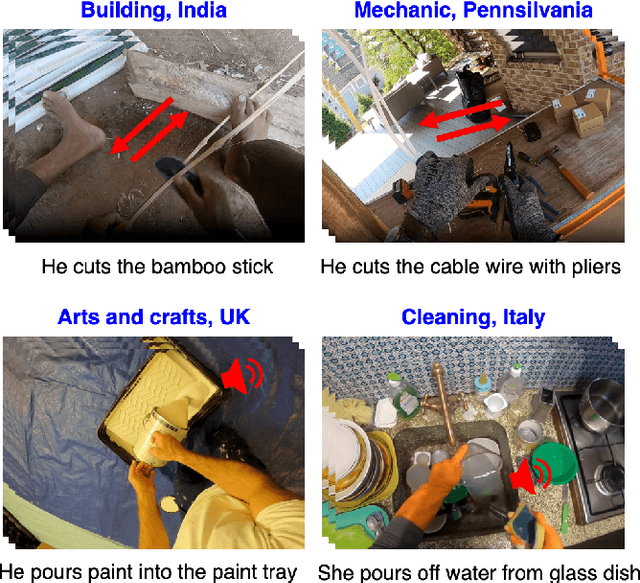
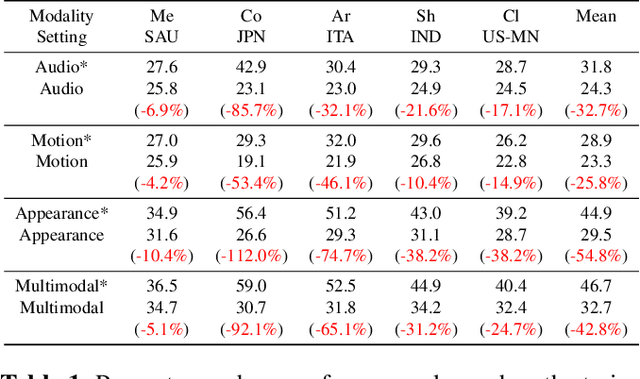


Abstract:First-person activity recognition is rapidly growing due to the widespread use of wearable cameras but faces challenges from domain shifts across different environments, such as varying objects or background scenes. We propose a multimodal framework that improves domain generalization by integrating motion, audio, and appearance features. Key contributions include analyzing the resilience of audio and motion features to domain shifts, using audio narrations for enhanced audio-text alignment, and applying consistency ratings between audio and visual narrations to optimize the impact of audio in recognition during training. Our approach achieves state-of-the-art performance on the ARGO1M dataset, effectively generalizing across unseen scenarios and locations.
What metrics of participation balance predict outcomes of collaborative learning with a robot?
May 17, 2024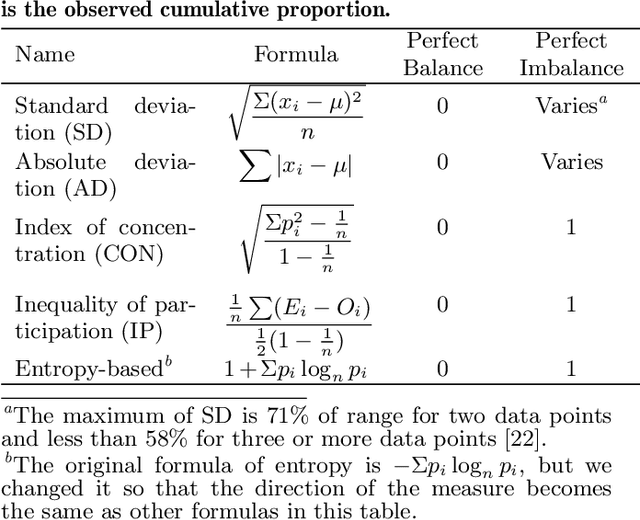

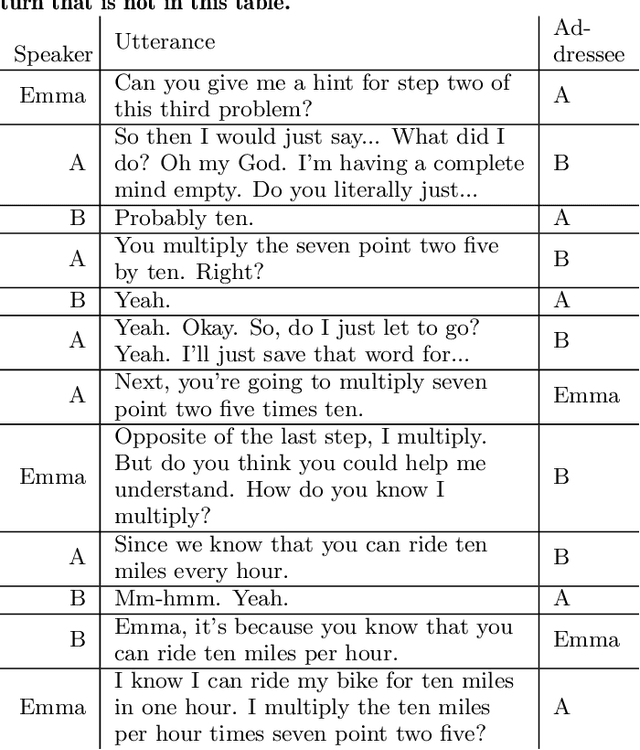
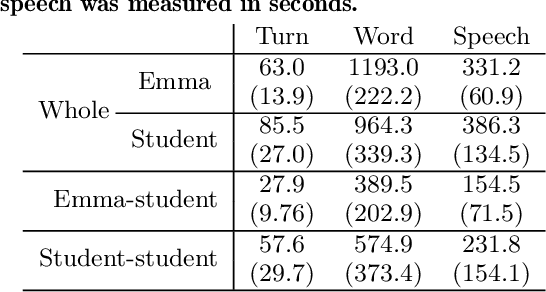
Abstract:One of the keys to the success of collaborative learning is balanced participation by all learners, but this does not always happen naturally. Pedagogical robots have the potential to facilitate balance. However, it remains unclear what participation balance robots should aim at; various metrics have been proposed, but it is still an open question whether we should balance human participation in human-human interactions (HHI) or human-robot interactions (HRI) and whether we should consider robots' participation in collaborative learning involving multiple humans and a robot. This paper examines collaborative learning between a pair of students and a teachable robot that acts as a peer tutee to answer the aforementioned question. Through an exploratory study, we hypothesize which balance metrics in the literature and which portions of dialogues (including vs. excluding robots' participation and human participation in HHI vs. HRI) will better predict learning as a group. We test the hypotheses with another study and replicate them with automatically obtained units of participation to simulate the information available to robots when they adaptively fix imbalances in real-time. Finally, we discuss recommendations on which metrics learning science researchers should choose when trying to understand how to facilitate collaboration.
Incorporating Geo-Diverse Knowledge into Prompting for Increased Geographical Robustness in Object Recognition
Jan 03, 2024Abstract:Existing object recognition models have been shown to lack robustness in diverse geographical scenarios due to significant domain shifts in design and context. Class representations need to be adapted to more accurately reflect an object concept under these shifts. In the absence of training data from target geographies, we hypothesize that geography-specific descriptive knowledge of object categories can be leveraged to enhance robustness. For this purpose, we explore the feasibility of probing a large-language model for geography-specific object knowledge, and we investigate integrating knowledge in zero-shot and learnable soft prompting with the CLIP vision-language model. In particular, we propose a geography knowledge regularization method to ensure that soft prompts trained on a source set of geographies generalize to an unseen target set of geographies. Our gains on DollarStreet when generalizing from a model trained only on data from Europe are as large as +2.8 on countries from Africa, and +4.6 on the hardest classes. We further show competitive performance vs. few-shot target training, and provide insights into how descriptive knowledge captures geographical differences.
 Add to Chrome
Add to Chrome Add to Firefox
Add to Firefox Add to Edge
Add to Edge